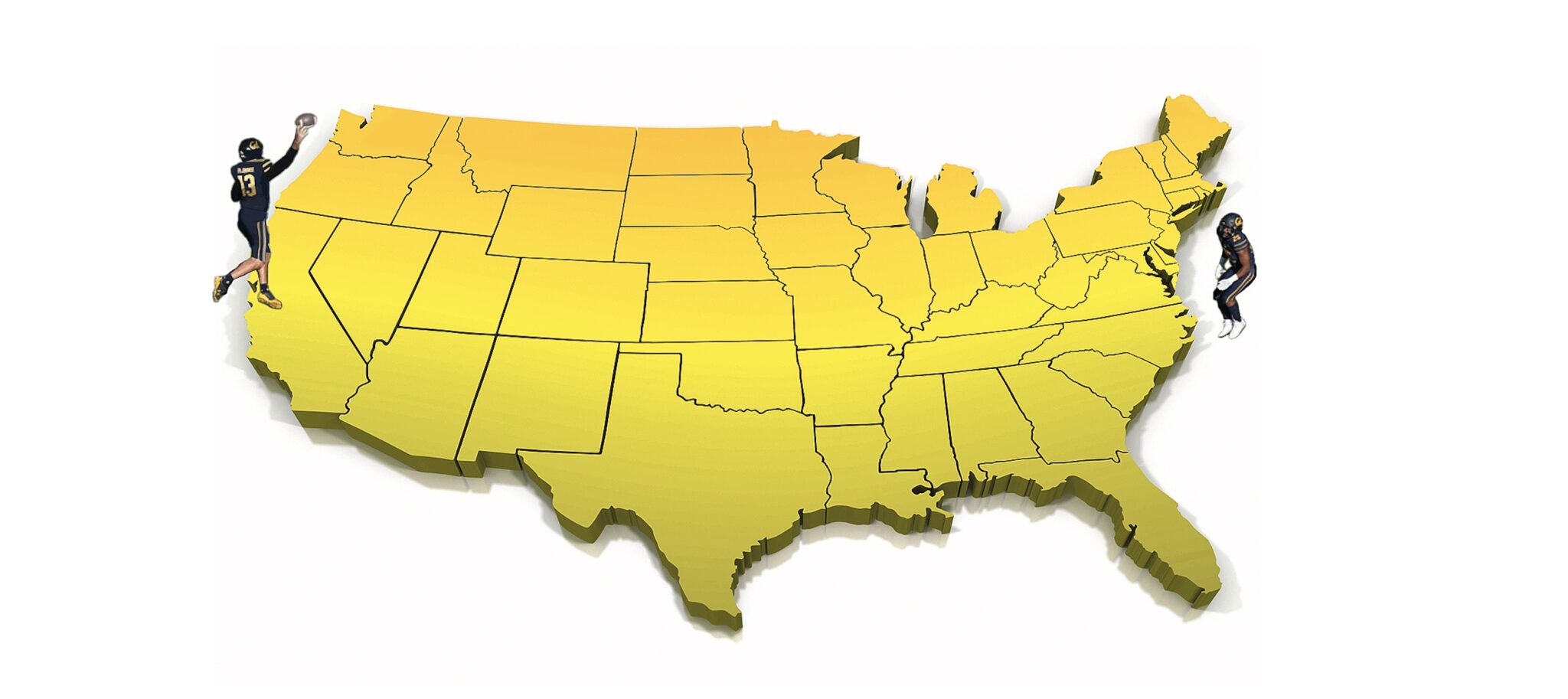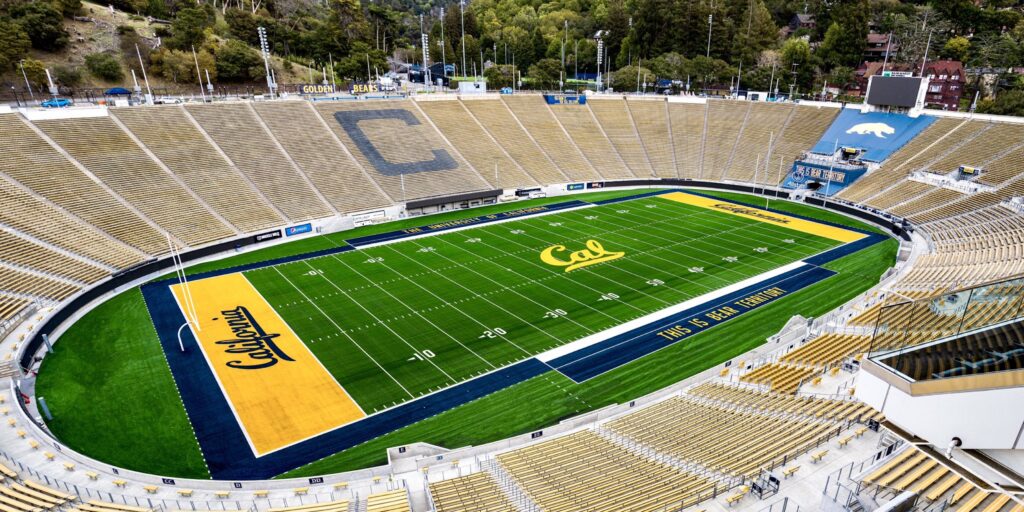It was July 25, and the schools of the Pac-12 were anxious and restless.
The trouble had started the previous summer, when the conference saw two of its foundational members, USC and UCLA, defect to the Big Ten. Now, after months of waiting, George Kliavkoff, the conference commissioner, had promised to finally present a new media deal to the remaining teams on August 1. Despite their growing anxiety, the leadership at each of the schools, including Cal, solemnly agreed to wait until the chosen day before making any decisions.
Just two days later, Colorado left.
A week later, so did Washington and Oregon. Then Arizona, Arizona State, and Utah. Suddenly, the Pac-12 had become the Pac-4: Only Cal, Stanford, Oregon State, and Washington State remained.
Fans were dismayed by the speed at which the conference collapsed, and even UC Berkeley Chancellor Carol Christ was caught off guard. “I was shocked, frankly, by the fact that people I trusted were clearly having other conversations,” Christ told California.
A month later, Cal too, would announce it was leaving, along with rival Stanford, to join the ACC—the Atlantic Coast Conference.
“It doesn’t make geographical sense, I know,” said Christ.
The Pac-12, which billed itself as the “Conference of Champions,” has existed in one form or another since 1915, when California, Washington, Oregon, and Oregon Agricultural College (now Oregon State) formed the Pacific Coast Conference at a meeting in Portland. Back then, Cal dominated the gridiron. The football team won its first conference title in 1918, and from 1920–24 was undefeated, winning four national championships. As more schools joined the conference, traditions and rivalries blossomed.
There have also been crises; the PCC was briefly dissolved in 1959 amid scandals involving illegal payments to athletes. It reformed as the Athletic Association of Western Universities, before becoming the Pac-8 in 1968.
In 2011, the then Pac-10 signed a 12-year deal with Fox and ESPN worth close to $3 billion. It was, at the time, the most lucrative contract in college sports history. In the end, however, it disappointed its members, who never actually received the amounts promised. Meanwhile, each of the other Power Five conferences negotiated new, more profitable media rights deals. By the time the Pac-12 contract’s expiration date was approaching in 2023, schools were antsy for something better.
They didn’t get it. The deal Kliavkoff proffered with Apple streaming paled in comparison with the competition’s and hinged on growing subscriptions.
With the Pac-12 down to four teams, the chancellor and the athletics director had to find another option quickly.
Christ says that, while they considered trying to rebuild the Pac-12, the path would have been a long and hard one. To leave a conference, she noted, schools generally have to pay an exorbitant exit fee, making recruiting new programs difficult.
Athletics Director Jim Knowlton sought input from the Student Athlete Advisory Committee. “[The student athletes] said, ‘Our number one priority is we want to compete at the highest level,’” he said. Their other requirements were that they play against schools with similar academic standards and that they maintain the student athlete experience they’ve become used to in the Pac-12, which includes perks like meals and road trip accommodations.
“There were only two conferences that allowed us to do all of that,” said Knowlton, referring to the ACC and the Big Ten. In the end, the ACC, which now comprises 15 schools, including Duke, UNC, and Virginia, was deemed the best choice; albeit, at considerable cost.
Cal will now enter a 12-year contract with the ACC where, for the first seven years it will only receive 30 percent of a full-member share of revenue, or somewhere from $10 to $20 million annually—a steep drop from the $37 million Cal got under its Pac-12 deal. The figure grows to a full share by year ten.
While likely the best deal available, it’s not great news for an athletics department that fields a large roster of teams while struggling annually with deficits.
“We just have to think hard about what a budget plan is going to be that will help us meet the financial challenge that athletics is going to face for the next nine years,” said Christ, who added that she did not want to cut any teams.
One lifeline for Cal could be the proposed “Berkeley Tax” the University of California regents will require UCLA to pay for moving to the Big Ten. The figure, as yet to be determined, could be anywhere from $2 to $10 million annually.
At the same time, travel costs will inevitably increase with the closest current ACC member more than 2,000 miles away. While Berkeley’s initial press release about the move stressed that 19 out of Cal’s 30 sports will experience either no or minimal travel changes, that still leaves a dozen programs heavily impacted.
“The teams that I’m really worried about are teams that play multiple games a week and typically in the gym or on the fields of the competing teams. So: men’s basketball, women’s basketball, men’s soccer, women’s soccer, baseball, softball, volleyball,” says Christ.
The chancellor says that they are trying to minimize travel, and Knowlton is working on scheduling models with the ACC right now and ways to support student athletes on the road.
“We’re going to look at every one of the sports on a case by case basis. What more will they need as far as resources? A baseball team that’s going to go out and play multiple games over a weekend, maybe we add a little bit more academic support in the way of a tutor or something else on the trip,” he said.
As for the fans, Knowlton emphasized that 1 in 10 Cal alumni live in the ACC corridor. For the other 90 percent, they will see half the football games played in Memorial Stadium. Still, no one is rejoicing.
“It just feels terrible to me that this wonderful conference with so many great traditions is collapsing,” said Christ. “I would much rather that we were looking forward, at the end of the season, to many more seasons of the Pac-12.”
Ultimately, neither Christ nor Knowlton know what the future holds for Cal in the long term. The 12-year ACC contract provides stability, but also takes the Bears off the market at a time when college football is in the midst of a volatile realignment that many observers feel will result in just a couple of superconferences dominating.
Amid all the upheaval, can Cal fans blame UCLA for causing everything to unravel? Christ says yes. “You know what they’re calling the UCLA payment?” she asked. “Cal-imony.”





















